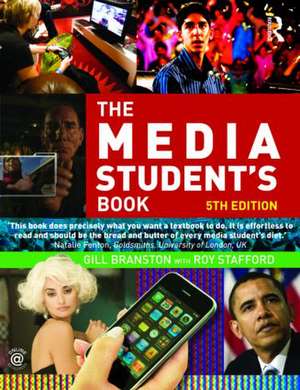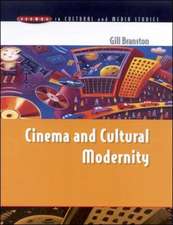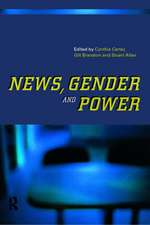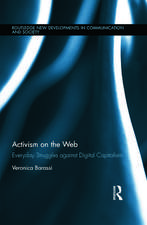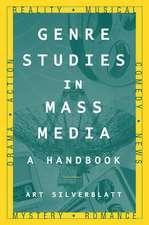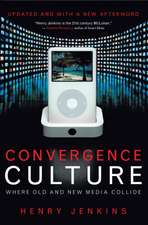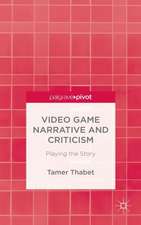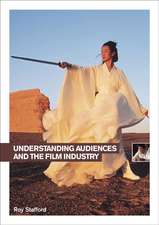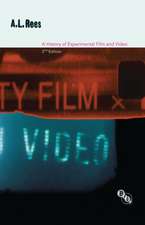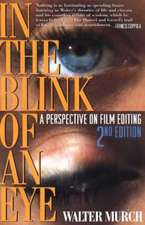The Media Student's Book
Autor Gill Branston, Roy Stafforden Limba Engleză Paperback – 27 mai 2010
Now in its fifth edition, this bestselling textbook has been thoroughly revised, re-ordered and updated, with many very recent examples and expanded coverage of the most important issues currently facing media studies. It is structured in three main parts, addressing key concepts, debates, and research skills, methods and resources. Individual chapters include:
- approaching media texts
- narrative
- genres and other classifications
- representations
- globalisation
- ideologies and discourses
- the business of media
- new media in a new world?
- the future of television
- regulation now
- debating advertising, branding and celebrity
- news and its futures
- documentary and ‘reality’ debates
- from ‘audience’ to ‘users’
- research: skills and methods.
- Slumdog Millionaire
- online access for film and music
- CSI and detective fictions
- Let the Right One In and The Orphanage
- PBS, BBC and HBO
- images of migration
- The Age of Stupid and climate change politics.
- a Companion Website with popular chapters from previous editions, extra case studies and further resources for teaching and learning, at: www.mediastudentsbook.com
- margin terms, definitions, photos, references (and even jokes), allied to a comprehensive glossary
- follow-up activities in ‘Explore’ boxes
- suggestions for further reading and online research
- references and examples from a rich range of media and media forms, including advertising, cinema, games, the internet, magazines, newspapers, photography, radio, and television.
Preț: 290.72 lei
Nou
Puncte Express: 436
Preț estimativ în valută:
55.63€ • 58.24$ • 46.03£
55.63€ • 58.24$ • 46.03£
Carte disponibilă
Livrare economică 17-31 martie
Livrare express 01-07 martie pentru 39.65 lei
Preluare comenzi: 021 569.72.76
Specificații
ISBN-13: 9780415558426
ISBN-10: 0415558425
Pagini: 488
Ilustrații: 192 colour illustrations
Dimensiuni: 189 x 246 x 23 mm
Greutate: 0.64 kg
Ediția:Revizuită
Editura: Taylor & Francis
Colecția Routledge
Locul publicării:Oxford, United Kingdom
ISBN-10: 0415558425
Pagini: 488
Ilustrații: 192 colour illustrations
Dimensiuni: 189 x 246 x 23 mm
Greutate: 0.64 kg
Ediția:Revizuită
Editura: Taylor & Francis
Colecția Routledge
Locul publicării:Oxford, United Kingdom
Public țintă
AS/A2 and UndergraduateCuprins
Introduction Section 1: Key Concepts 1. Approaching Media Texts Case Study: Visual and Aural Signs 2. Narratives Case Study: CSI: Miami and Crime Fiction 3. Genres and Classification Case study: Formats and Genres Case Study: Horror as Popular Art The Orphanage and Let the Right One In 4. Representations Case Study 1: US Plantation Stereotyping Case Study 2: Representations and Gender Case Study: Images of Migration 5. Globalisation Case Study: Slumdog Millionaire: Global Film? 6. Ideologies and Discourses Case Study: The Age of Stupid (UK 2009) and Climate Change Politics 7. Media as Business Case Study: Music and Movies – Digital and Available Section 2 : Debates 8. ‘New Media’ in a ‘New World’? 9. The Future of Television 10. Regulation Now 11. Debating Advertising, Branding and Celebrity Case study: ‘Brangelina’ 12. News and its Futures 13. Documentary and ‘Reality’ Debates 14. From ‘Audience’ to ‘Users’ Section 3 : Research Methods and Reference 15. Research: Skills and Methods Glossary Index
Notă biografică
Gill Branston is Honorary Senior Lecturer at the School of Journalism, Media and Cultural Studies at Cardiff University. Roy Stafford is a freelance lecturer, writer and examiner in media education and training.
Recenzii
"This book does precisely what you want a textbook to do. It brings students to a wide range of concepts, issues and debates in media studies and sets them within critical, yet accessible, contexts. Through a guided and fully illustrated tour of textual, political, economic, social, technological and regulatory concerns the reader is encouraged to grasp the fundamentals of the field. It is littered with both contemporary and classic examples, links to online resources and probing questions to both cement understanding and challenge assumptions. It is effortless to read and should be the bread and butter of every media student’s diet." – Natalie Fenton, Goldsmiths, University of London
"The fifth edition of The Media Student’s Book is the best textbook on the media available on the planet today. It is an invaluable resource not just for students, but also for scholars of media and cultural studies. Beautifully produced, with full-colour images, informative sidebars and information boxes working in tandem with Gill Branston and Roy Stafford’s engaging text, the new edition addresses every and any topic in media studies today: documentaries, new media, globalization, advertising, news, and media regulation. With a key chapter on research methods and innumerable ideas for activities, assignments and projects, this book will find a home in media studies courses everywhere." – Imre Szeman, University of Alberta, Canada
"A terrific new edition, a re-write which takes on the challenges of Web 2 and uses it to explore and analyse the complexity of media production and use. A brilliant introduction to media studies with a range of accessible and up-to-date examples and student exercises which are thought-provoking and engaging. The re-design presents the material vividly and the cross-referencing to the companion website makes this a superb resource. Case studies provide an excellent basis for course activity while the clear advice on research methods and references is invaluable support for project work. The editors are experienced teachers and it shows.
Branston and Stafford’s enthusiasm for a wide range of media is infectious but they don’t shy away from tricky issues like media ownership, regulation and environmental impact. In such a fast-moving world, updating this classic text book was an almost impossible task; to do it so well is a tremendous achievement." – Christine Geraghty, University of Glasgow
"This is an excellent core text for first year undergraduates, offering breadth, balance and a wealth of guidance towards further reading and research. " – Christa van Raalte, Teesside University
"The fifth edition of The Media Student’s Book is the best edition yet. Its reorganized and revised contents make the material more accessible and also provide valuable updated overviews of contemporary developments in both new and longer-standing forms of media. One of the book’s major strengths is its combination of detailed up-to-date accounts of contemporary media forms together with a deeper historical and theoretical perspective. The widespread inclusion of discussions and case studies on media texts and genres which have emerged since the fourth edition also ensures the book’s continuing ability to dialogue with media students and to provide a focused account of the contemporary media landscape." –Hilary Dannenberg, University of Trier, Germany
"This book breaks down the discipline into concepts, then shows how each one links to others. It makes sense of the huge interdisciplinary area of media studies by providing clear definitions of key concepts, illustrated with up-to-date examples and a wealth of external links. The language is simple and direct without being patronising. As well as allowing students to understand different approaches within media studies, this book will be a useful tool in essay writing and other assessment projects. Perhaps most importantly, because of the range of examples used and its thought-provoking style, I think after reading this, students will apply what they read and through that at least begin to understand the media around them. I think both lecturers and students will find this interesting, stimulating and very useful." – Carole Fleming, Nottingham Trent University
"Branston and Stafford still offer the best, one-stop resource for media studies with an incredible range of material and contemporary case studies presented in a conversational style. The book links itself to the broader mediasphere through the archiving of additional material online and references sending students to youtube clips and short films, encouraging students to be active participants in the process of learning about media rather than simply passive readers of the text.
Through the expansive coverage, information distilled and ideas on display, The Media Student’s Book will remain a valuable resource for students throughout their studies, as well as for many academics and those involved in the analysis and creation of media more generally." – Jason Bainbridge, Swinburne University of Technology, Australia
Student Feedback:
"The new edition is great! It is accessible and easy to relate to. The use of normal everyday examples that a student will have come across instead of academic (probably unseen ones) makes understanding difficult theories and philosophies easy and straight-forward. It is like somebody your age is explaining it. I like how it acknowledges the change in the way people learn, with a greater reliance on the internet and absorbs this into its design and layout. The 'Explore' sections are also really well put together as they make you aware of all the media things that saturate your day-to-day life that you have grown to ignore or take for granted, and they make you take a step back and critically analyse them." – Charlotte Dean, Media Studies student at St Andrews University
"I think that the new edition is fantastic. It's very comprehensive and the examples used are very relevant to the topics discussed. I like the side information as it explains key concepts for readers who may not be aware of their meaning. Also, the extra websites and exercises I feel will enhance learning and allows the student to interact more with the topics covered. In the introduction, I like how readers can feedback to the publishers directly by email. I think it displays two-way media and new media culture very well." – Anna Jordan, Media Studies student at Stirling University
"The fifth edition of The Media Student’s Book is the best textbook on the media available on the planet today. It is an invaluable resource not just for students, but also for scholars of media and cultural studies. Beautifully produced, with full-colour images, informative sidebars and information boxes working in tandem with Gill Branston and Roy Stafford’s engaging text, the new edition addresses every and any topic in media studies today: documentaries, new media, globalization, advertising, news, and media regulation. With a key chapter on research methods and innumerable ideas for activities, assignments and projects, this book will find a home in media studies courses everywhere." – Imre Szeman, University of Alberta, Canada
"A terrific new edition, a re-write which takes on the challenges of Web 2 and uses it to explore and analyse the complexity of media production and use. A brilliant introduction to media studies with a range of accessible and up-to-date examples and student exercises which are thought-provoking and engaging. The re-design presents the material vividly and the cross-referencing to the companion website makes this a superb resource. Case studies provide an excellent basis for course activity while the clear advice on research methods and references is invaluable support for project work. The editors are experienced teachers and it shows.
Branston and Stafford’s enthusiasm for a wide range of media is infectious but they don’t shy away from tricky issues like media ownership, regulation and environmental impact. In such a fast-moving world, updating this classic text book was an almost impossible task; to do it so well is a tremendous achievement." – Christine Geraghty, University of Glasgow
"This is an excellent core text for first year undergraduates, offering breadth, balance and a wealth of guidance towards further reading and research. " – Christa van Raalte, Teesside University
"The fifth edition of The Media Student’s Book is the best edition yet. Its reorganized and revised contents make the material more accessible and also provide valuable updated overviews of contemporary developments in both new and longer-standing forms of media. One of the book’s major strengths is its combination of detailed up-to-date accounts of contemporary media forms together with a deeper historical and theoretical perspective. The widespread inclusion of discussions and case studies on media texts and genres which have emerged since the fourth edition also ensures the book’s continuing ability to dialogue with media students and to provide a focused account of the contemporary media landscape." –Hilary Dannenberg, University of Trier, Germany
"This book breaks down the discipline into concepts, then shows how each one links to others. It makes sense of the huge interdisciplinary area of media studies by providing clear definitions of key concepts, illustrated with up-to-date examples and a wealth of external links. The language is simple and direct without being patronising. As well as allowing students to understand different approaches within media studies, this book will be a useful tool in essay writing and other assessment projects. Perhaps most importantly, because of the range of examples used and its thought-provoking style, I think after reading this, students will apply what they read and through that at least begin to understand the media around them. I think both lecturers and students will find this interesting, stimulating and very useful." – Carole Fleming, Nottingham Trent University
"Branston and Stafford still offer the best, one-stop resource for media studies with an incredible range of material and contemporary case studies presented in a conversational style. The book links itself to the broader mediasphere through the archiving of additional material online and references sending students to youtube clips and short films, encouraging students to be active participants in the process of learning about media rather than simply passive readers of the text.
Through the expansive coverage, information distilled and ideas on display, The Media Student’s Book will remain a valuable resource for students throughout their studies, as well as for many academics and those involved in the analysis and creation of media more generally." – Jason Bainbridge, Swinburne University of Technology, Australia
Student Feedback:
"The new edition is great! It is accessible and easy to relate to. The use of normal everyday examples that a student will have come across instead of academic (probably unseen ones) makes understanding difficult theories and philosophies easy and straight-forward. It is like somebody your age is explaining it. I like how it acknowledges the change in the way people learn, with a greater reliance on the internet and absorbs this into its design and layout. The 'Explore' sections are also really well put together as they make you aware of all the media things that saturate your day-to-day life that you have grown to ignore or take for granted, and they make you take a step back and critically analyse them." – Charlotte Dean, Media Studies student at St Andrews University
"I think that the new edition is fantastic. It's very comprehensive and the examples used are very relevant to the topics discussed. I like the side information as it explains key concepts for readers who may not be aware of their meaning. Also, the extra websites and exercises I feel will enhance learning and allows the student to interact more with the topics covered. In the introduction, I like how readers can feedback to the publishers directly by email. I think it displays two-way media and new media culture very well." – Anna Jordan, Media Studies student at Stirling University
